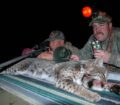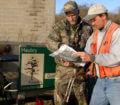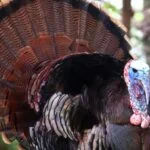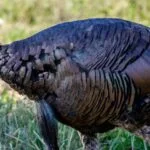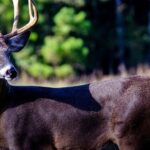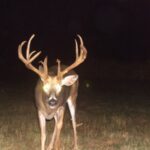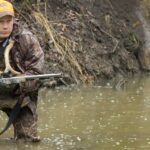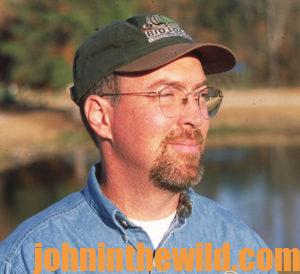 Editor’s Note: To grow trophy bucks, you must have an area with nutrient-rich soils. But even if you don’t have extremely-fertile soil, you can raise bigger bucks faster by fertilizing the food plots, naturally-occurring plants and mast-producing trees and bushes on the land you hunt. There are numerous products that will help enhance the growth, development and nutritional output of food for deer. Let’s take a look at some discoveries that can enable you to not only see more deer but actually take more deer.
Editor’s Note: To grow trophy bucks, you must have an area with nutrient-rich soils. But even if you don’t have extremely-fertile soil, you can raise bigger bucks faster by fertilizing the food plots, naturally-occurring plants and mast-producing trees and bushes on the land you hunt. There are numerous products that will help enhance the growth, development and nutritional output of food for deer. Let’s take a look at some discoveries that can enable you to not only see more deer but actually take more deer.
How to Build a Deer Honey Hole:
Deer hunters realize how difficult attracting deer out into the open where you can see them is. If you’ve pinpointed a productive location to hunt deer, more than likely your buddies will have found that same spot. They may take your buck before you have the opportunity. However, any new native plant fertilizer with a time-released nitrogen formula of 36-3-37 or something similar enables you to fertilize naturally-occurring deer foods like greenbrier, blackberries, honeysuckle and other grasses and shrubs deer eat. Fertilized plants will attract deer to the spot where you want to take them. Too, if you’re clever with your fertilizing, you can create honey holes for deer other hunters won’t find. I like to go into thick-cover areas, locate small openings and fertilize the wild native plants on the edges of those openings. Most hunters won’t penetrate thick cover to try and find a secret hunting spot. But even if someone stumbles on my secret place, they can’t determine why deer come to that area to feed. By having several remote, invisible deer-feeding places, even if a hunter does find one of my honey holes, I’ll have other spots I can hunt without interference.
One caution, however: never fertilize an entire naturally-occurring food source with fertilizer. If you do, the deer may completely eat the food source and won’t return to the region you’ve fertilized. You generally only have to apply time-released native plant fertilizer twice a year: once in the spring and once in the late summer. Scientists have learned that deer tend to search out and eat the most highly-nutritious and abundant food they can find. Native plant fertilizer causes plants to put on more leaves and/or more fruit than the plants will without the application of fertilizer. Also, the fertilized plants seem more palatable to the deer than unfertilized plants.
Think about, if you have the choice of picking thousands of small, dried blackberries to make pies or picking hundreds of thumb-sized, plump and full-of-flavor blackberries, which will you select for your pie? Although deer don’t make pies, they’ll choose the fertilized blackberries – the plump, juicy ones – just like you will. University tests show that proper fertilization of native plants will improve their protein content by over 150 percent, increasing a deer’s body and antler size that depend on high levels of protein. By using native plant fertilizer, you can create a honey hole that attracts deer during hunting 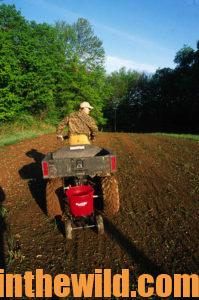 season and a feeding site that produces high levels of crude protein to help the deer on your property grow heavier antlers and bigger bodies.
season and a feeding site that produces high levels of crude protein to help the deer on your property grow heavier antlers and bigger bodies.
How to Have Better, Bigger Nuts and Fruit:
If you want to produce more and bigger bucks during the fall, you need to fertilize native fruit and nut-bearing trees now. But let’s face the fact that no one wants to carry a 50-pound bag of fertilizer and a posthole digger through the woods to fertilize trees. To solve this problem, use time-released tree tablets, which generally contain 20-10-5 fertilizer plus minerals. Tree tablets often come in a small box with 150 tablets that weigh only 21-grams each. If you don’t want to do the math, 100 tablets at 21 grams each equals about 5 pounds, a weight you can put into the back of your hunting vest to carry with you into the woods.
To get the fertilizer down to the trees:
*use an auger or a dibble to make holes every 3 feet, directly below the spread of the tree’s branches. Make the holes 1 – 1-1/2-inches in diameter and 6-inches deep.
* place one tablet into each hole, and cover with soil. Then you don’t have to fertilize these trees again for up to 2 years.
How to Fertilize Trees You Plant This Season for Deer:
You also can use tree tablets for fertilizing newly-planted trees to draw in wildlife, if you follow these instructions:
* use four tablets per 1 inch of tree trunk diameter, as measured 1 foot above the soil. For example, a tree with a 3-inch trunk diameter requires 12 tablets.
* place the tablets evenly around the root ball, about half way from the bottom of the planting hole and approximately 1 inch outside the root ball. Then, a tree will produce bigger, tastier and more-palatable nuts or fruit for deer
How to Build Honey Holes with Tree Tablets:
I particularly enjoy using tree tablets to fertilize certain nut trees and wild fruit trees like apples and persimmons that produce nuts and fruit at different times of the year. For instance, if I know the swamp chestnut trees in the area I hunt will be the first oak trees to drop their acorns each year, I’ll choose two 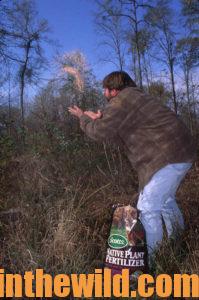 swamp chestnut trees in two different locations to fertilize with tree tablets. Next, I’ll fertilize another type of oak like the white oak that drops its acorns a little later than the swamp chestnut. Then I’ll fertilize specific red oak trees that either produce nuts later than the white oak or all year long. I’ve learned to only fertilize one tree of a particular kind in each region I plan to hunt to concentrate the deer on the fertilized trees dropping acorns. Usually I’ll select acorn trees close to thick-cover areas. Then the deer can step out of the thick cover, feed on the acorns and easily return to the cover. Deer never like to expose themselves to the openings for an extended time, especially during hunting season. By providing the bucks with highly nutritious-food close to a thick-cover spot, the bucks more likely will feed during daylight hours on the fertilized acorns.
swamp chestnut trees in two different locations to fertilize with tree tablets. Next, I’ll fertilize another type of oak like the white oak that drops its acorns a little later than the swamp chestnut. Then I’ll fertilize specific red oak trees that either produce nuts later than the white oak or all year long. I’ve learned to only fertilize one tree of a particular kind in each region I plan to hunt to concentrate the deer on the fertilized trees dropping acorns. Usually I’ll select acorn trees close to thick-cover areas. Then the deer can step out of the thick cover, feed on the acorns and easily return to the cover. Deer never like to expose themselves to the openings for an extended time, especially during hunting season. By providing the bucks with highly nutritious-food close to a thick-cover spot, the bucks more likely will feed during daylight hours on the fertilized acorns.
How to Have the Most-Productive Green Field:
“A 1-acre food plot can make a tremendous difference in the amount of food available for the deer to eat,” explains deer researcher Dr. Grant Woods of Readsville, Missouri. “A quality food plot should produce 2,000 to 10,000 pounds of dry forage per acre per year.” According to Woods, the hardwood forests in the United States only will produce about 200 pounds of dry forage per acre. An acre of cutover land probably will produce 1,000 to 2,000 pounds of dry forage per acre. Therefore, by planting highly-nutritious food plots with seeds, you not only can increase the amount of food available for deer to eat but also the quality of that food.
What’s the Best Game Plan for Deer:
To drastically increase your odds for taking a trophy buck this season, consider this fertilizer game plan I’ve found to be highly productive.
* Find the trails deer use going from their feeding to their bedding sites.
* Fertilize nut trees, shrubs and grasses in thick cover close to the deer’s bedding sites. By having highly-nutritious deer food near a deer’s bed, the deer often will stop and feed at this site as it leaves from or returns to its bedding area. If you put a tree stand near the site you’ve fertilized, then you can take a buck in the early morning or late afternoon.
* Fertilize certain trees, shrubs or grasses on which the deer normally feed along the trail the animal takes to its primary food source, possibly a green field, an agricultural field or a nut-producing tree everyone on your hunting lease has identified as a hot spot. This tactic may help you get a buck to stop and feed before he reaches his primary food source.
* Fertilize trees, shrubs or grasses in thick-cover places close to the deer’s food source. If an older-aged-class buck feeds in an agricultural field or on a planted green field, he’ll often hold in thick cover close to that feeding site and wait until nightfall to move out into the field. By fertilizing foods a buck can 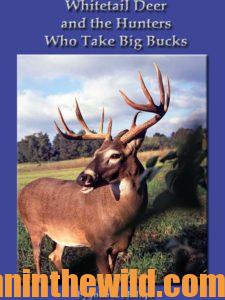 snack on before he goes to the field after dark, you can create a honey hole where you can take a big buck just before nightfall. Remember, fertilizer has two tremendous benefits for the hunter. It can enable you to bring deer out into the open and will increase the amount of nutritious food for your deer herd, which grows bigger and healthier deer. Using fertilizer as a hunting tool to grow and take deer may be one of the best-kept secrets in all outdoors.
snack on before he goes to the field after dark, you can create a honey hole where you can take a big buck just before nightfall. Remember, fertilizer has two tremendous benefits for the hunter. It can enable you to bring deer out into the open and will increase the amount of nutritious food for your deer herd, which grows bigger and healthier deer. Using fertilizer as a hunting tool to grow and take deer may be one of the best-kept secrets in all outdoors.
To learn more about deer hunting, check out John E. Phillips’ book, “Whitetail Deer and the Hunters Who Take Big Bucks,” available in Kindle and print versions at http://amzn.to/2bYwYOK
Tomorrow: Why Look for Your Deer Lease Now and What to Consider

